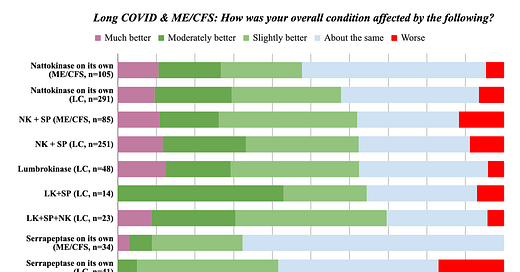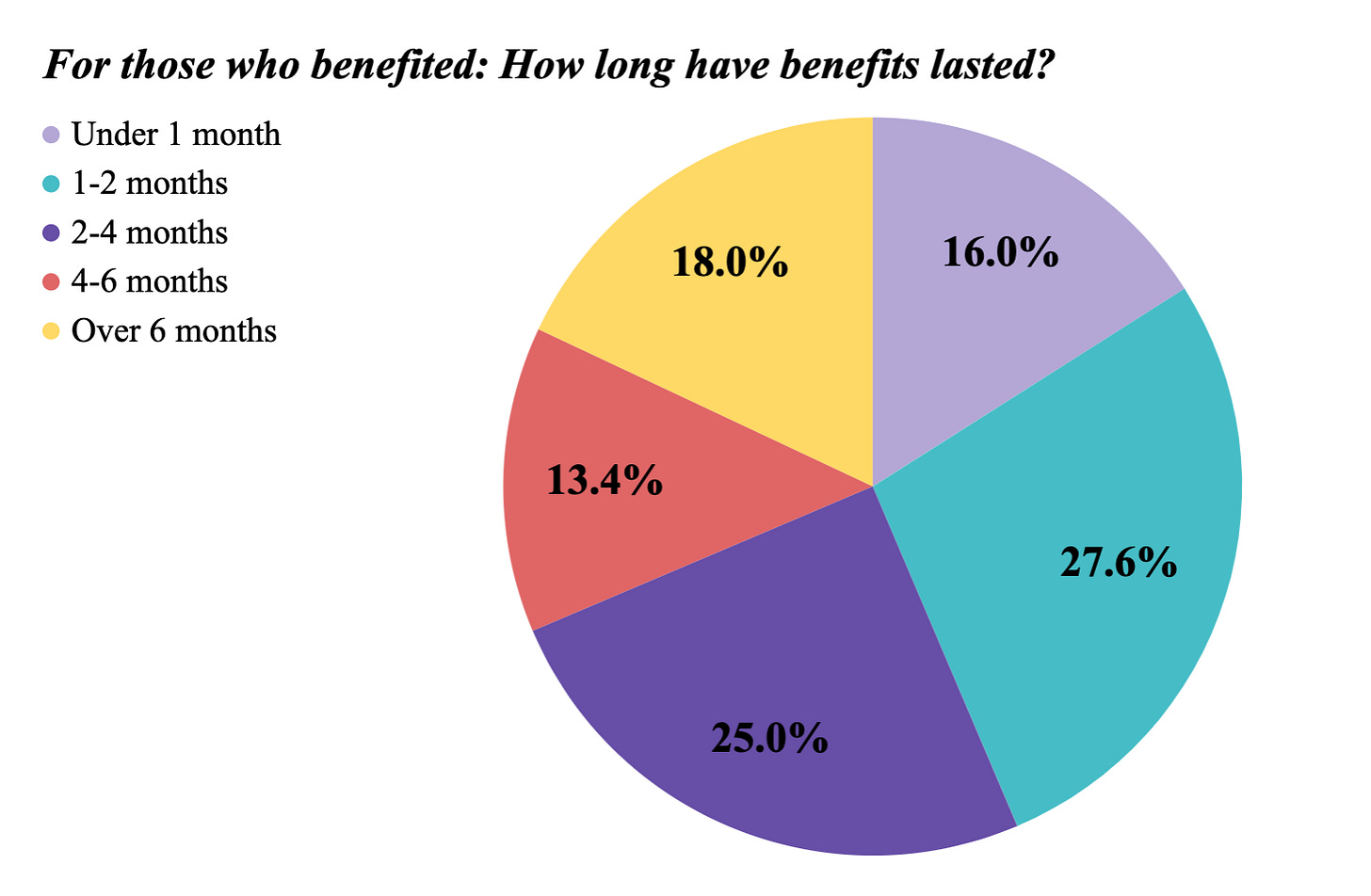TREAT ME Survey: Individual Treatment Results
Proteolytic Enzymes (Nattokinase, Lumbrokinase, Serrapeptase)
Thank you to all who completed my recent TREAT ME survey! This is the first in a series of articles covering survey results on individual treatments. At a later date, a comprehensive overview of treatments with more general information will be shared. Today I will share results on the popular supplements nattokinase (NK), lumbrokinase (LK), and serrapeptase (SP), so let’s dive in!
What degree of benefits did respondents report with different combinations of NK, SP and LK?
I was curious to see if there were any significant differences between monotherapies or certain combinations (i.e., NK vs LK vs NK+SP, et al). It was immediately clear that SP monotherapy is significantly less effective compared to both NK and LK monotherapy. This was expected considering that the fibrinolytic potency of serrapeptase is ~1/30th that of nattokinase and ~1/300th that of Boluoke. Other than that, the differences were not so striking. Across the board (except for SP), 10-12.5% reported their overall condition was “much better,” while around 15-21% improved moderately and a larger percentage improved just slightly. In those with ME/CFS, it appears that NK+SP might be a bit more effective than NK on its own: NK alone helped 47.5% whereas NK+SP helped 61% (p=0.06).
What about duration of illness? Are those who have been sicker longer less likely to improve with these enzymes?
Good news: It appears that these enzymes work similarly regardless of duration of illness.
Quite a few respondents experimented with 3 or 4 different combinations (NK+SP, NK alone, NK+SP+LK, etc), so for the purposes of this particular data set, I only included the most beneficial supplement or combo for each individual so that each respondent received one vote. For example, if one individual rated NK alone as “about the same,” NK+SP as “slightly worse,” and LK as “moderately better,” their vote is cast for “moderately better” here. (In the data set above where I searched for differences in effectiveness between different combos & monotherapies, every response from each respondent was included.)
62% to 69% of Long COVID respondents reported experiencing some level of benefit from these enzymes across all durations. (Please note that only 26 respondents have had Long COVID for the shortest duration (3-6 months), so those percents may be prone to more inaccuracies compared to categories with around 100 or more respondents.) While the total percent of long-haulers who benefited to any degree tends to remain consistent across all durations, the percent of those who benefited moderately to very much appears to decline. For example, 49 of 131 (37.4%) of 6-12 month long-haulers vs 21 of 96 (21.9%) of 1.5-2.5 year long-haulers reported feeling moderately to very much better—a statistically significant 15.5% difference (p=0.012). However, 2.5+ year long-haulers reject this inchoate trend, reporting degrees of benefit on par with those with LC for 6-12 months. Therefore, I am more inclined to believe that duration of illness does not tend to reduce degree of benefit. See the graphs below followed by data for ME/CFS.
Proteolytic enzymes appear more beneficial in Long COVID than in ME/CFS, overall helping around 14% more respondents to any total degree (66% vs 52% over all durations), which was a statistically significant difference (p<0.001). However, these enzymes still do help over half of those with ME/CFS who try them, and in those with ME/CFS for 5 or more years, around 30% reported benefiting not just slightly, but moderately to very much. Furthermore, I believe benefits can be optimized with the right combination and dose.
In ME/CFS, it appears that proteolytic enzymes might actually help more later in the course of the disease. 13% of 61 with ME/CFS under five years versus 30% of 122 with ME/CFS for greater than 5 years reported enzymes benefited them moderately to very much (p=0.01). This could be due to the progression & evolution of ME/CFS symptoms over the years. For example, it is plausible that it takes quite a few years for hypercoagulability or other vascular issues to develop in ME/CFS, whereas in Long COVID, onset of cardiovascular issues & microclots is more swift.
How well did proteolytic enzymes reportedly combat certain symptoms?
28 symptoms were surveyed. Please review the bar graph below. Symptoms that improved most commonly in Long COVID were fatigue (56%), brain fog (55%), memory problems (47%), feeling of weakness (46.5%), PEM (46%), shortness of breath (40%), chest pain (36.5%), and fast/fluttering/pounding heart (33%). The most common side effects were gastrointestinal (nausea, vomiting, and other GI issues).
Similarly but with comparatively less frequency than in Long Covid, symptoms that improved most commonly in ME/CFS were fatigue (48%), brain fog (46%), chest pain (43%), feeling of weakness (33%), PEM (33%), memory problems (31%), and fast/fluttering/pounding heart (23%).
How well-tolerated were various combinations of proteolytic enzymes?
Quite well-tolerated, in fact. For example, in those taking nattokinase alone, 65% reported side effects did not bother them at all, 15% & 9% reported slightly & moderately bothersome side effects, and 6% & 4% reported NK side effects bothered them “quite a bit” & “very much,” respectively (n = 397). Other combinations are shown below. (Please note that the alternating administration schedules in the last 4 categories had a very small sample size (n = 18 total) so we cannot conclude that these combinations have fewer to no side effects!)
How many respondents discontinued proteolytic enzymes due to bleeding or hospitalization?
23 out of 735 (3.1%) reported that they stopped therapy due to bleeding or hospitalization. Three were taking SP only, five were taking lumbrokinase, seven were taking NK and eight were taking NK/SP. Of those 23, four provided more information about the nature of the adverse event and why they discontinued:
Large bruise following dog scratch
Month-long menstrual bleeding
Nightly nosebleeds following ~3 months of NK+SP
“Not sure if bleeding problem but intense stomach issues led to me stopping”
How soon do most people notice benefits from proteolytic enzymes?
The vast majority (3/4) reported benefits in under 2 weeks, and 42% noticed benefits within just 1 week.
In those who reported no benefits, the vast majority trialed proteolytic enzymes for an adequate duration:
Those who benefited took on average higher doses. For example, if we compare those who trialed the same exact brand (Doctor’s Best nattokinase), 37% who benefited vs 18% who did not benefit tried doses 8,000 FUs or higher.
What about specific brands of nattokinase and lumbrokinase? Did some brands appear more effective than others?
More data are needed in this arena to identify what nuances may exist between brands. Below is a table showing patient reports from any brand that received at least 20 responses, but ideally each brand would be trialed by many more. Doctor’s Best Nattokinase and Doctor’s Best Natto-Serra (combo) were by far the most commonly used brands (n=205 & n=177, respectively) with an adequate sample size, followed by Solaray’s Nattokinase (n=42) and Solaray’s NK-SP combo (n=27). For lumbrokinase, Doctor’s Best was most commonly trialed (n=32) followed by Boluoke (n = 30) and Dr. Mercola (n = 20).
While the sample size was much lower, Solaray’s NK-SP appears particularly promising, with 74% reporting sustained benefits. Compared to Doctor’s Best Natto-Serra, this difference (21%) was statistically significant (p<0.04). In a follow-up survey, I plan to ask about the degree of benefit when asking about brands which will illustrate a better picture of any smaller nuances between brands (i.e., slight vs moderate improvements, etc). Note that in general, more respondents reported benefits in brands with acid resistant coatings, which jives with my previous survey work.
An additional 17% reported benefits with Solaray’s NK/SP combo compared to its solo nattokinase product (74 vs 57%). This could be due to addition of SP but it could also be due to dose: Solaray’s NK monotherapy contains only 1,250 FU per capsule whereas the combo product contains 3,000 FU of NK. Those taking the combo on average were taking much higher doses.
Two brands that almost made the n = 20 cutoff were NOW Nattokinase (n = 18, 39% sustained benefit) and Neprinol (n = 15, 47% with sustained benefit). NOW’s relatively poor ranking is consistent with my previous survey.
It is worth noting that Best Naturals Nattokinase ranked well and it is also quite inexpensive at just $10 for #90 capsules. This is even cheaper than the popular Doctor’s Best NK which goes for $13 for #90. (Note: I do not use affiliate links or make any money from highlighting any specific brands.)
When respondents say their benefits were “sustained,” how long does that actually mean?
These results are ongoing as many surveyed had only recently started proteolytic enzymes. 44% reporting sustained benefits stated their benefits have lasted ≤2 months thus far, while 31% reported benefits lasting at least 4 months.
Did benefits persist after discontinuation?
More data is needed because most respondents have not yet discontinued therapy. Of those who did, 22% reported their symptoms did NOT return, 44% reported “some” symptoms returned, 16% reported “most” symptoms returned, and 18% reported ALL symptoms returned.
I may add some more info in this article later, but I wanted to share the information analyzed up to this point. I hope this information was helpful. If you are able to donate to help fund this volunteer project, please press the button below. Thank you!!
















Great article. Please consider doing Lactoferrin and apolactoferrin survey as well. Lot's of people are having success on it.
The Solaray NK/SP strength is 1.5 x that of Doctor's Best NK/SP- wondering if that accounts for the higher response rate since this chart does not appear to take dosing equivalency into account.